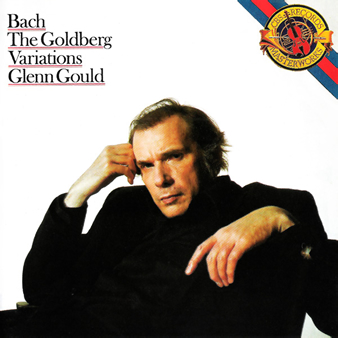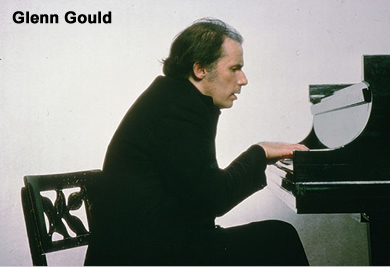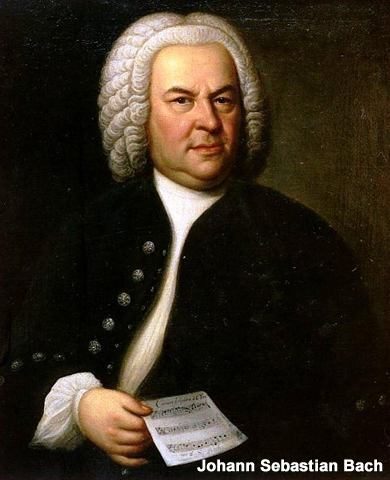 Johann Sebastian Bach (1685-1750)
Johann Sebastian Bach (1685-1750)
Glenn Gould, Pianist (CBS RECORDS MASTERWORKS)
Recorded at 30th Street Recording Studios, New York City – May 1981.
ONE-SENTENCE REVIEW:
Brilliant (but can someone please stop that infernal humming in the background…kidding)
ORIGINAL LINER NOTES (uncredited):
In 1955, a young Canadian pianist made his first recording for what was then Columbia Masterworks. At that time he was not well-known to concert audiences and was completely unknown to the record market. But after the recording sessions of June of that year, in Columbia’s famous 30th Street Studios in New York City, and after the release of his first album, Bach’s Goldberg Variations, Glenn Gould became world-famous.
 His performance of Bach’s 1742 collection of “keyboard exercises” created an international recording sensation and achieved the unique distinction of becoming an album that, from its original release data to the present, was never absent from the active catalog of Masterworks recordings.
His performance of Bach’s 1742 collection of “keyboard exercises” created an international recording sensation and achieved the unique distinction of becoming an album that, from its original release data to the present, was never absent from the active catalog of Masterworks recordings.
In 1970, Glenn Gould completed a recording session at the 30th Street Studios and decided that in the future he would record exclusively in Toronto, where his television and film activities were center. He did not again return to this musically historical building until 1980 when he began making his first digital recordings for CBS Masterworks – the Six Last Sonatas of Haydn and the Goldberg Variations.
Why did Glenn Gould, who seldom records a piece twice, choose to re-record a work that had received a definitive performance at his hands 27 years ago?
Gould has offered only the explanation that new technology plus his own desire to reexamine the work in terms of its “arithmetical correspondence between theme and variation” led him back into the studio for this recording.
Any more complete explanation of this new approach would, according to Gould, entail a complete written analysis, in an almost book-length essay, of the “thirty very interesting but independent-minded pieces” that make up the Variations – a fascinating prospect, to be sure.
Samuel H. Carter, who co-produced the Last Six Sonatas of Haydn, also worked on the new Goldberg Variations. Following are some of his observations of the last recording sessions:
Sometime past midnight on Saturday, May 27, 1981, the doors of CBS’s famous 30th Street Recording Studios in New York closed on the last official recording session to be held there by CBS Masterworks.
 Out of those doors walked a man – assuredly only after a “cool down” period and change of shirt – a man whose illustrious recording career began there a little over a quarter century before. With an appropriateness that is usually found only in fiction, the last notes played by Glenn Gould that night were from the same work of Bach – the Goldberg Variations – with which he had first transfixed the music world in the summer of 1955.
Out of those doors walked a man – assuredly only after a “cool down” period and change of shirt – a man whose illustrious recording career began there a little over a quarter century before. With an appropriateness that is usually found only in fiction, the last notes played by Glenn Gould that night were from the same work of Bach – the Goldberg Variations – with which he had first transfixed the music world in the summer of 1955.
Now the Studio, once a kind of mecca for some of the world’s greatest musicians, was to be sold, victim of the changed fortunes of an industry that has become as multinational as any other and as competitive.
For Glenn Gould and for those of us whose association with “Columbia” covers a long span of years, the old church is a place where many ghosts walk in an atmosphere so laden as to be almost claustrophobic, in spite of the soaring reaches of the ceilings.
Glenn Gould may have quietly come out by the same door wherein he entered but while he had been inside he stirred things up more than a little. Pablo Casals once said that Bach is “a volcano,” speaking of course of the emotional content of the music that traditionalists tried so hard for so long to deny.
Gould, too, is something of a volcanic force. He is the embodiment of musical sophistication in that he seems always to know what he intends the music to do. He almost never lets the music happen to him – he happens to it. That is what made many musicians who nominally “knew” the Goldberg Variations feel that they had just discovered them when the 1955 album appeared.
 May I suggest that, with this new recording, many additional “discoveries” will be made. The nature of these will doubtless be as many and various as the number of listeners.
May I suggest that, with this new recording, many additional “discoveries” will be made. The nature of these will doubtless be as many and various as the number of listeners.
I think of Glenn Gould as an artist of strong intentionality. He shapes and molds a musical line in its breadth and in its detail with breathtaking awareness. As he has often told interviewers, he will try to make each performance different, yet this firm intention is always present so that however different the “take” there is never any tentativeness or absence of character.
This new digital recording of the Goldberg Variations was made, in the main, simultaneously with a video taping. Make-up sessions were held on April 25 and May 29 for the purposes of the recording.
Having worked extensively in both mediums as performer and producer, Glenn was almost instantly aware, in seeing and hearing a playback, of what takes or portions of takes were suitable for the film and recording and which for the film only. I often felt that he was being excessively nit-picking, only to discover in the intensive listening and editing sessions that followed that he had known precisely the difference he wanted in ever case.
He is a man who is very reluctant to accept anything short of the absolute attainment of his artistic goal.
TRACK LISTING:
- 1 – Goldberg Variations, BWV 988 [51:00]
https://youtu.be/qo6VfM0PSlQ
FINAL THOUGHT:
“I don’t know know much about classical music – for years I thought the Goldberg Variations were something Mr. and Mrs. Goldberg did on their wedding night.” – Woody Allen (Stardust Memories). Of course this recording gets my highest rating!
 Emily Sachs – President – Manka Music Group (A division of Manka Bros. Studios – The World’s Largest Media Company)
Emily Sachs – President – Manka Music Group (A division of Manka Bros. Studios – The World’s Largest Media Company)


